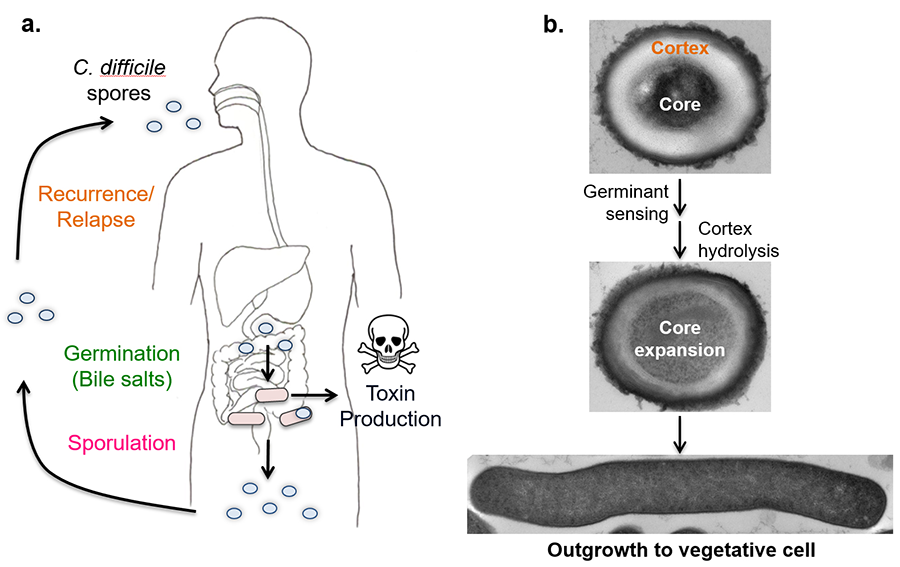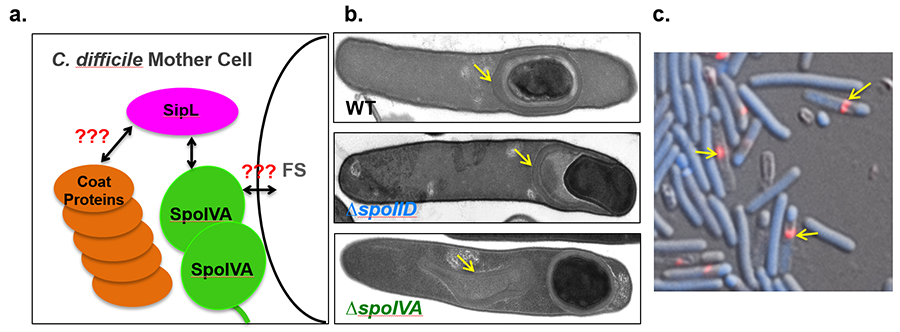The Aimee Shen Lab
Bacterial endospores are the hardiest forms of life on earth. Our lab focuses on understanding how these resistant, metabolically dormant spores are constructed during sporulation, and how they transform back into vegetative cells during germination. We are studying these developmental processes in Clostridium difficile, since it is a leading cause of antibiotic-associated diarrhea and gastroenteritis-associated death worldwide, and spores are critical to its pathogenesis.
Spores and the infection cycle of Clostridium difficile
Spores are the infectious particle of C. difficile, since it is an obligate anaerobe. Thus, C. difficile must form spores in order to survive exit from the host and transmit disease, and those spores must germinate in the gastrointestinal tract in order to initiate infection (Figure 1). Furthermore, spores contribute to high rates of C. difficile disease recurrence (~20%), since they are inert to antibiotics, resistant to commonly used disinfectants, and readily disseminated.
Figure 1. (a) Overview of the C. difficile infection cycle. Following germination and spore outgrowth in the mammalian gut, C. difficile vegetative cells secrete toxins that cause gut inflammation, and ~10% of vegetative cells will induce sporulation. (b) Electron microscopy analysis of spore germination. Cortex hydrolysis leads to hydration of cytosol (core), which allows metabolism and outgrowth to occur.
Despite the importance of sporulation and spore germination to infection, relatively little is known about the molecular mechanisms controlling these developmental processes. Using transcriptional profiling, proteomics, and genetics, we have identified novel regulators of both spore formation and germination, some of which are unique to C. difficile and its closest relatives. Research in our lab is directed at elucidating how these regulators control functional spore formation with the long-term goal of contributing to the development of spore-specific therapies.
C. difficile spore formation
Upon sensing unidentified environmental cues, C. difficile induces sporulation and divides asymmetrically. The larger mother cell engulfs the smaller forespore, generating an endospore in the mother cell cytosol that undergoes further maturation. A key step in this process is the assembly of a protective spore coat, a series of proteinaceous shells that surround the forespore. We have identified regulators of both engulfment and coat assembly that are essential for producing functional spores (Figure 2); one of these regulators is unique to the Clostridia (SipL). We are interrogating how these regulators control engulfment and coat assembly using electron microscopy, fluorescent imaging reporters, genetics, biochemistry, proteomics, and chemical biology.
Figure 2. Coat assembly in C. difficile. (a) SpoIVA and SipL regulate coat localization of the forespore (FS) and are required for functional spore formation. (b) Electron microscopy reveals coat localization defects (yellow arrow) in engulfment mutants and ∆spoIVA. (c) Fluorescence microscopy of an engulfment mutant shows mislocalization of a labeled coat protein (red) relative to the forespore (stained with Hoechst and visible by DIC).
C. difficile spore germination
C. difficile spores germinate in response to specific bile salts produced in the mammalian gut. A unique signaling pathway controls germinant sensing in C. difficile and its closest relatives. The germinant receptor and pseudoprotease, CspC, triggers a signaling cascade that leads to the proteolytic activation of SleC, a cortex hydrolase. SleC-mediated degradation of the cortex is essential for spores to outgrow into vegetative cells. We have identified key regulators of this signaling process and determined their functions (Figure 3). We are using genetics, structural biology, proteomics, electron microscopy, and fluorescent imaging reports to elucidate their precise mechanisms of action.
Figure 3. (a) Electron microscopy of wildtype spores exposed to bile salt germinant (Adapted from Fimlaid et al. PLoS Pathogens 2015). (b) The germinant receptor, CspC, senses bile salts and activates the protease CspB, which cleaves and activates SleC. The CspA pseudoprotease controls CspC incorporation into mature spores. The lipoprotein GerS is required for SleC activity for unknown reasons. SleC activation leads to cortex hydrolysis, which is necessary for dipicolinic acid (DPA) release and spore outgrowth.



